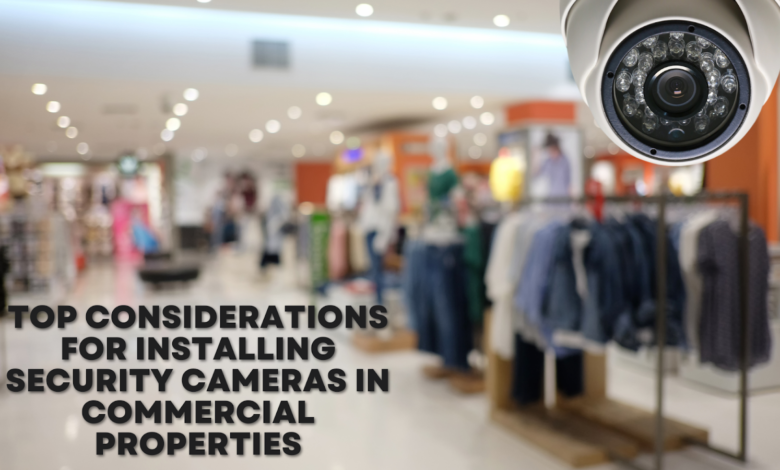10 Top Considerations for Installing Security Cameras in Commercial Properties

Installing a comprehensive security camera system is one of the best decisions a commercial property owner can make. With global spending on commercial security expected to reach $96 billion by 2025, it’s clear that businesses are prioritizing safety and surveillance capabilities.
In this guide, we’ll explore the top 10 considerations for installing security cameras to maximize coverage, effectiveness, and return on investment.
Why a Security Camera System is Crucial
A security camera system acts as a silent sentry, deterring crime while providing irrefutable video evidence if an incident does occur. According to industry experts, properties with visible security cameras were 300% less likely to be targeted by burglars.
Commercial properties require security cameras as they host a line of businesses. Security cameras are crucial for businesses to deter theft, vandalism, and unauthorized access, providing a proactive measure to enhance safety and protect assets. They also serve as valuable evidence in case of incidents, aiding in investigations and liability management.
Business security cameras offer a proactive and effective solution to safeguard assets, deter potential threats, and provide invaluable monitoring capabilities for enhanced safety and peace of mind.
Other benefits include:
- Enhanced ability to monitor staff and customers
- Live footage for prompt incident response
- Video analytics to derive actionable insights
- Evidence for insurance claims and liability lawsuits
Ultimately, security cameras provide ubiquitous protection that no guard or lock can match. As the saying goes:
The best locks in the world won’t stop someone who wants to get in, but the best camera will catch them doing it.
Key Components of a Security Camera System
A commercial security camera system has four key components working in tandem:
Security Cameras: To capture and store video footage. They are available in a wide range with capabilities to suit specific needs.
Local Storage: To store video recordings, network video recorders (NVRs) are used which have specialized operating systems for handling IP camera data.
Cloud Connectivity: In multi-location businesses, you can enable remote access to footage via internet connectivity.
Video Analytics: Includes facial recognition, motion detection, suspicious activity alerts, and more to perform intelligent video analysis.
Together, these components collect, store, analyze, and transmit video data – creating an end-to-end smart surveillance system.
Determining the Right Cameras and Installation
With a myriad of security cameras available, how do you determine the right solution? These are the key aspects to evaluate:
Camera hardware: Different form factors like domes, bullets, and PTZs, meet aesthetic and mounting needs. Fixed vs PTZ cameras each have their advantages and limitations.
Video resolution: 720P is the lower range (1280×720 pixels) while 1080P (1920×1080), and 4K (4096×2160) provide greater image clarity.
Night vision: Look for cameras with infrared (IR) that emit a light source while others enhance light sensitivity for detail. Since, performance during low light is critical.
Wide angle lenses: The wider the view, the better the surveillance, therefore go for 90° to 180° fields of view available to suit the surveillance area.
Outdoor rating: Verify for IP66, IP67 or IP68 ratings to ensure cameras can withstand dust, rain, and temperature extremes.
Power over Ethernet (PoE): Cameras that use PoE require only one cable for data transmission and power. This simplifies installation and wiring.
Professional installation is highly recommended over DIY methods to fully leverage these capabilities while concealing cabling for the best results.
Strategic Security Camera Placement
More security cameras do not always equal better surveillance. Strategic placement matters greatly. Apply these tips when planning:
- Mount fixed-view cameras at vantage points to cover choke points like entry/exit areas.
- Complement with PTZ cameras in large spaces and adjust focus dynamically based on activity.
- Ensure sufficient camera height (ideally >15 ft) that allows a commanding top-down view.
- Think like an intruder – what areas seem secluded and vulnerable to exploitation? Place cameras there preemptively.
- Avoid physical obstructions like signs, trees, or overhangs in the camera’s field of view.
- For warehouses and perimeter security, distribute cameras systematically to eliminate dead zones.
Also, account for lighting conditions – additional illumination may be required in poorly lit areas for night surveillance. As the saying goes, lighting outweighs security cameras.
Top 10 Considerations for Installing Security Cameras
When installing security cameras in commercial properties, it’s crucial to consider various factors to ensure comprehensive coverage and effective surveillance. Here are the top 10 considerations:
Risk Assessment: Conduct a thorough risk assessment to identify vulnerable areas and potential security threats specific to your commercial property.
Legal Compliance: Understand and comply with local laws and regulations regarding surveillance and privacy. Ensure that your camera installations adhere to legal requirements.
Camera Placement: Strategically position cameras to cover critical entry points, high-traffic areas, parking lots, and other vulnerable spots. Consider the field of view and ensure minimal blind spots.
Camera Types: Choose the right types of cameras for different areas, such as dome cameras for indoor spaces, bullet cameras for outdoor coverage, and PTZ (Pan-Tilt-Zoom) cameras for flexible monitoring.
Resolution and Image Quality: Opt for high-resolution cameras to capture clear and detailed footage. This is essential for identification purposes and can be valuable evidence in case of incidents.
Lighting Conditions: Consider lighting conditions at different times of the day. Choose cameras equipped with features like low-light sensitivity or infrared capabilities for effective surveillance in various lighting environments.
Storage and Retention: Determine the required storage capacity for video footage and establish a retention policy. Consider cloud storage options and ensure that your system can store an adequate amount of footage.
Integration with Security Systems: Ensure seamless integration with other security systems, such as access control and alarm systems. This enables a more comprehensive and automated security setup.
Regular Maintenance: Implement a regular maintenance schedule for the cameras and associated equipment. This includes checking for firmware updates, cleaning lenses, and ensuring all components are functioning correctly.
Cybersecurity Measures: Implement cybersecurity measures to protect the camera system from hacking or unauthorized access. Change default passwords, regularly update firmware, and use secure networks for camera connectivity.
By carefully considering these factors, you can enhance the effectiveness of your security camera system in a commercial property, creating a safer environment for employees, customers, and assets.
Key Legal Aspects to Consider
While security cameras promise immense value, several legal considerations exist:
- Video surveillance laws regulate consent, privacy, and disclosure. Know your state’s laws.
- Recording audio may or may not require consent from those being recorded. Confirm local laws.
- Workplace recording laws limit surveillance of employees in non-work areas like break rooms.
- Signage requirements for alerting people that recording is in progress.
Consult a legal expert to ensure full compliance. This prevents lawsuits and keeps footage admissible as evidence.
FAQs
- What types of security cameras are best?
Depends on your needs! We recommend varifocal dome cameras for most indoor spaces, and bullet cameras for large outdoor areas. Ensure the cameras have adequate resolution, night vision capabilities, wiring options, and weather resistance.
- How do I choose a security camera system provider?
Shortlist providers that offer professional consultation, customized recommendations to address vulnerabilities, robust cybersecurity protocols, responsive customer service, and full-service installation and maintenance support.
- What kind of maintenance is required after installation?
While modern security cameras are quite durable, periodic cleaning of lenses, firmware updates, activity log reviews, and system health checks are recommended. Most providers offer maintenance contracts for a nominal fee.
Conclusion
Installing a customized security camera system tailored to your commercial facility takes research, expert guidance, and some investment upfront. But the 24/7 protection and loss prevention delivered make it one of the wisest decisions you can make to secure your enterprise. Reach out for a free consultation today with leading security camera system providers near you.



